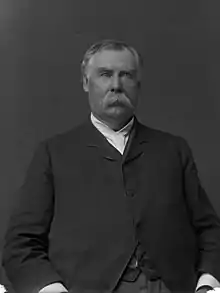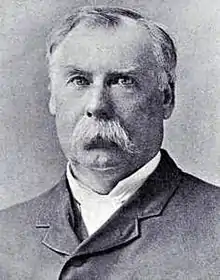Peter McLaren (politician)
Peter McLaren (September 21, 1833 – May 23, 1919) was a Canadian politician and Senator from Ontario. McLaren was the Plaintiff in McLaren v Caldwell, that resulted in the landmark decision of the Judicial Committee of the Privy Council that upheld provincial jurisdiction in matters of a local or private nature, as well as over property and civil rights.
Peter McLaren | |
|---|---|
 | |
| Senator for Perth, Ontario | |
| In office February 21, 1890 – May 23, 1919 | |
| Appointed by | John A. Macdonald |
| Personal details | |
| Born | September 21, 1833 Lanark, Upper Canada |
| Died | May 23, 1919 (aged 85) Perth, Ontario, Canada |
| Political party | Conservative |
| Spouse | Sophia Lees |
| Occupation |
|
| Known for | McLaren v Caldwell |
Early life
McLaren was on September 21, 1833, in Lanark, Upper Canada, he was the son of James McLaren, an immigrant from Scotland. He married Sophia, the daughter of Conservative politician William Lees and granddaughter of Andrew W. Playfair.[1]
Business life
McLaren was involved in the timber trade and operated sawmills in Carleton Place and at McLaren's depot on the Kingston and Pembroke Railway line[2] as well as in Alberta.[3]
Rivers and Streams Act
In 1881, the 4th Ontario parliament passed the Rivers and Streams Act, mainly due to a dispute between McLaren and a rival lumber company over access to McLaren's timber slides on the Mississippi River.[4][5] The enactment gave the right to individuals to flow logs down rivers, creeks, and streams, and allowed those who made improvements along a river to receive a toll set by the lieutenant governor from others floating logs down a river.[4] The Ontario law was disallowed by the John A. Macdonald government.[6] The report on disallowance cited removal property rights from individuals down river who would be forced to become "toll-keeper against his will",[4] which amounted to taking away the "rights of one man and vest them in another" which a legislatures power to do so was deemed "exceedingly doubtful".[7] The decision to disallow the Act went against the principles of disallowance Macdonald previously authored in 1868, and was protested by the Premier of Ontario Oliver Mowat and opposition in Parliament, including Wilfrid Laurier.[7][8][9] Further accusations came from the opposition claiming the decision was motivated, as McLaren who petitioned for disallowance was a known political friend of Macdonald.[7] Macdonald's conservative government was unsuccessful at arguing that this disallowance aligned with previous decisions, and conservative Dalton McCarthy conceded in parliament that the disallowance was based on a new principle.[10] Macdonald defended the decision on the concept of protecting property rights and it was within the general interest of the Dominion to maintain those rights to ensure continued certainty in investment.[11] Gérard La Forest believed the report authorizing the disallowance was not authored by justice minister James McDonald was actually written by John A. Macdonald, as McDonald would cease his role as justice minister only a few days after its publication.[4]
The Ontario legislature protested the disallowance and passed the same Act three more times, all of which were disallowed, and finally a fourth attempt in 1884 which was not disallowed and continued as law.[11][8] The issue was settled in the landmark case McLaren v Caldwell by the Judicial Committee of the Privy Council which upheld the enactment.[12][13]
Political life
McLaren was appointed to the Senate of Canada in 1890 on the advice of John Alexander Macdonald representing the senatorial division of Perth, Ontario. A Conservative, he served 29 years[14] until his death in 1919.[14]
Death

McLaren died in Perth on May 23, 1919.[2] His estate was valued at $15 million.[15]
In 1962, Mount McLaren in Alberta's Canadian Rockies was named in his honor.[16]
References
- The Canadian Parliament; biographical sketches and photo-engravures of the senators and members of the House of Commons of Canada. Being the Tenth Parliament Elected November 3, 1904. Montreal: The Perrault Printing Company. 1906. p. 102. OCLC 697903568.
- Brown, Howard Morton (2007). Lanark Legacy: Nineteenth Century Glimpses of an Ontario County. General Store Publishing House. pp. 230–242. ISBN 978-1-897113-62-2.
- Crowsnest Pass Historical Society (1979). Crowsnest and its people. Coleman: Crowsnest Pass Historical Society. p. 27. ISBN 0-88925-046-4.
- La Forest 1955, p. 53.
- Stevenson 1993, p. 73.
- Romney, Paul (1999). Getting it wrong: how Canadians forgot their past and imperilled Confederation. University of Toronto Press. pp. 112–5. ISBN 0-8020-8105-3.
- La Forest 1955, p. 54.
- Creighton 1970, p. 48.
- La Forest 1955, p. 62.
- La Forest 1955, p. 55.
- La Forest 1955, p. 56.
- Stevenson 1993, p. 74.
- Caldwell and another v McLaren [1884] UKPC 21, (1884) 9 AC 392 (7 April 1884), P.C. (on appeal from Canada)
- Peter McLaren – Parliament of Canada biography
- "DECISION RESERVED IN M'LAREN CASE: Senator's Trustees Oppose Ruling Given by Justice Masten". The Globe. December 22, 1921. p. 9. ProQuest 1366180919.
- "Mount McLaren". Geographical Names Data Base. Natural Resources Canada. Retrieved 2022-11-02.
- Works cited
- Creighton, Donald (1970). Canada's First Century. Toronto: Macmillan of Canada. ISBN 0-7705-0066-8.
- La Forest, Gerard V. (1955). Disallowance and Reservation of Provincial Legislation. Ottawa: Canada. Department of Justice. hdl:2027/uc1.c025712080.
- Stevenson, Garth (1993). Ex uno plures : federal provincial relations in Canada, 1867–1896. Montreal: McGill-Queen's University Press. ISBN 978-0-7735-0986-3.